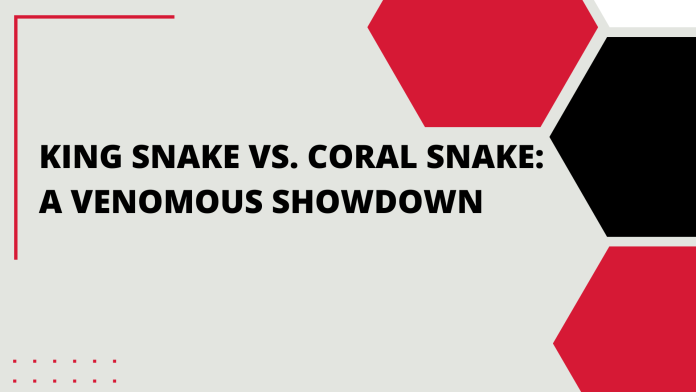King Snake vs Coral Snake, When it comes to snakes, nature has painted a stunning canvas of colors, patterns, and behaviors. Among the many species, the king snake and coral snake stand out, not only for their vibrant appearances but also for their venomous nature. In this article, we’ll explore the intriguing world of these two serpents, delving into their characteristics, behaviors, and the crucial differences that set them apart.
The Battle of Colorful Venom: Appearance and Identification
1. King Snake
King snakes are often referred to as the “kingsnakes” due to their habit of hunting and consuming other snakes, including venomous ones. These snakes typically showcase bold and striking color patterns. They have a glossy black base color with white, yellow, or red bands encircling their bodies. This vibrant contrast is believed to be a mimicry of the venomous coral snakes, a defense mechanism to ward off potential predators.
1.1. Physical Characteristics
- Length: King snakes can grow up to 3 to 4 feet in length.
- Scales: Their scales are smooth and glossy.
- Head Shape: They possess a relatively short and rounded head.
- Eyes: Round pupils characterize their eyes.
2. Coral Snake
Coral snakes are renowned for their exquisite yet deadly appearance. They display a sequence of colorful bands that vary from red, yellow, and black. The classic rhyme “red touches yellow, kill a fellow; red touches black, venom lack” is often used to distinguish them from non-venomous look-alikes.
2.1. Physical Characteristics
- Length: Coral snakes are smaller, usually measuring about 2 feet in length.
- Scales: They have smooth, glossy scales similar to king snakes.
- Head Shape: Their heads are slender and elongated.
- Eyes: Coral snakes have round pupils, like king snakes.
Venomous Arsenal: The Bite
3. King Snake
The king snake is not known for its deadly venom. In fact, it is non-venomous to humans. While they may have some mild venom, it is harmless to us. However, they do possess potent constricting abilities, which they use to overpower their prey.
3.1. Diet
- King snakes primarily feed on other snakes, rodents, birds, and eggs.
- They are often seen as nature’s pest controllers.
4. Coral Snake
Conversely, the coral snake possesses highly potent venom, which is neurotoxic. Though they are not aggressive, their venom can be deadly to humans if left untreated. Bites are rare due to their reclusive nature, but caution should always be exercised when encountering a coral snake.
4.1. Diet
- Coral snakes primarily prey on other small reptiles and amphibians.
- They have fangs at the rear of their mouths, making biting larger prey difficult.
Distribution and Habitat
5. King Snake
King snakes are widely distributed across North and Central America. They adapt well to various environments, including forests, grasslands, and even urban areas. Their adaptability has made them a common sight in many regions.
5.1. Behavior
- King snakes are known for their bold and fearless demeanor.
- They are often seen crossing roads, and motorists should take care to avoid them.
6. Coral Snake
Coral snakes are more elusive and are found in the southeastern United States. They prefer wooded and sandy areas and are rarely encountered in urban settings.
6.1. Behavior
- Coral snakes are secretive and prefer to avoid confrontation.
- They spend much of their time hidden beneath leaf litter or in burrows.
Conclusion
In the world of snakes, the king snake and coral snake present a fascinating contrast. While the king snake is known for its mimicry, non-venomous nature, and fearless demeanor, the coral snake stands out with its striking colors and potent neurotoxic venom. Both have their roles to play in the delicate balance of their ecosystems.
As with any wildlife encounter, it’s crucial to exercise caution and respect for these creatures and their habitats. If you ever come across a snake in the wild, remember to observe from a safe distance and avoid unnecessary risks.
FAQs
- Are king snakes dangerous to humans?
- No, king snakes are not dangerous to humans. They are non-venomous.
- Can you keep king snakes as pets?
- Yes, king snakes are popular as pets for reptile enthusiasts.
- Are coral snakes aggressive?
- Coral snakes are not aggressive, but they should be handled with caution due to their venom.
- Do coral snakes have predators?
- Predators of coral snakes include certain birds and larger snakes.
- What should I do if bitten by a coral snake?
- Seek immediate medical attention if bitten by a coral snake, as their venom can be lethal without prompt treatment.
In this article, we’ve explored the mesmerizing world of king snakes and coral snakes, shedding light on their appearances, behaviors, and the critical distinctions that set them apart. Whether you encounter these creatures in the wild or choose to keep them as pets, understanding their unique characteristics is essential for coexisting harmoniously with these serpentine wonders.

